Article
The Civil War Sesquicentennial in Missouri: "Meet Me in St. Louis"
Author(s):
The state of Missouri is marking the 150th anniversary of the start of the Civil War with a magnificent exhibition in the Missouri History Museum in St. Louis.
The war that almost destroyed the nation started 150 years ago. We all know the states suffered grievously, some more than others. The impact on Missouri was particularly poignant because of the lawsuit by the enslaved Dred Scott seeking his freedom dragged on for 11 years adding to the unrest that finally led to the outbreak of war.
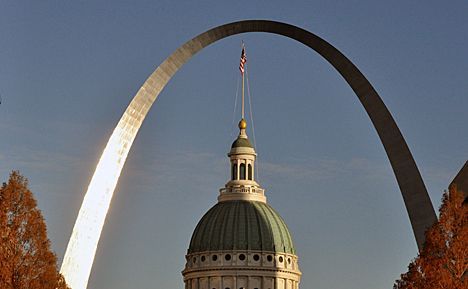
The state of Missouri is marking the 150th anniversary of the start of the war with a magnificent exhibition in the Missouri History Museum in St. Louis. Called “The Civil War in Missouri” it opened Nov. 13 and is running until March 16, 2013 —
and it shows the bitter, brutal divide between secessionist and Union preservationists. Many other locations in this city that is “the Crossroads of America” offer additional glimpses of this terrible war.
“The Civil War in Missouri” exhibition is both fascinating and detailed. It could easily occupy the usual museum visitor for two hours and a Civil War buff the entire day. Particularly interesting to physicians might be the display cases of surgical and medical artifacts.
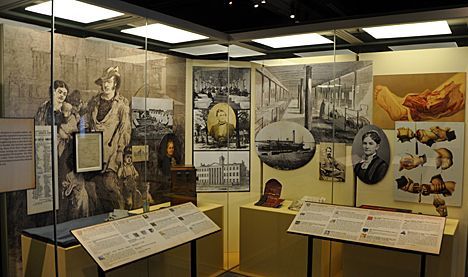
One display explains how the Battle of Wilson’s Creek brought to light how ill-equipped medical services on both sides were to transport and treat their casualties. The Ladies’ Union Aid Society was formed and operated by prominent St. Louis women to provide medical supplies and services to both Union soldiers and civilian refugees.
“The positions of responsibility —
particularly as nurses in battle … challenged attitudes about women’s abilities and places in society,” the display says.
The sepia photograph of Dr. John Thompson Hodgen, ca. 1860, portrays the Surgeon General of Missouri who created the simple “Hodgen splint” that was easily applied over a broken limb. He operated during the war in City Hospital.
Behind his photograph lie wartime images of the Carver General Hospital in Washington, DC and of the Hospital at Jefferson Barracks and the Hospital of the Sisters of Charity in St. Louis. More than 23,000 wounded soldiers arrived in St. Louis the first year.
The face of Adaline Couzins, photographed around 1863, looks out at visitors from the display case also. She was one of the few nurses to receive a government pension after the war. She “collected supplies, searched for wounded on battlefields, and nursed the wounded on hospital ships ... She was fearless in the face of danger —
she was shot in the knees during the Battle of Vicksburg.”

The page showing 1837 surgical instructions for amputation is from the Becker Medical Library, Washington University School of Medicine. The surgical instruments shown are the USA Hospital Department Surgical Set ca. 1860-1870. The kit included bone-cutting forceps, amputation knives and saws, discs of hemostatic bone wax and a tourniquet (missing from this set).
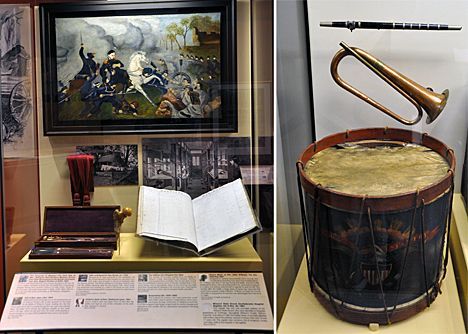
The Interior of a Hospital Car 1864
Another display case has an amputation kit 1859-1860 and the Missouri State Guard (Confederate) Hospital Register from July 5 to December 25, 1861. It gives the details of soldiers admitted after Wilson’s Creek; many of them only 16 and 17 years old. The register sits in front of an image that shows wounded being moved by train.
Fall of General Lyon
The painting covers the death of the first general in the War to die in combat; his uniform sash was taken from his tent after the Battle of Wilson’s Creek. Nearby, another display case suggests the morale boosting of regimental bands.
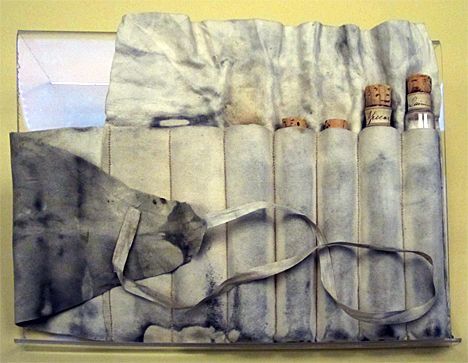
Th
ere was morale boosting for the patient, too, when the army doctor went not into his kit to select a saw but into his medicine case to relieve symptoms. The case displayed belonged to Dr. John Green, ca. 1860-1880. Dover’s Power, a compound of opium and ipecac, was one of the medicines always kept in a kit. Jalap and rhei were used for dysentery as well. They were surely needed.

A walk around this comprehensive exhibition reveals weapons, soldiers, famous figures, speeches and, of course, politicians. After all, it’s been said, “War happens when politicians run out of ideas.”
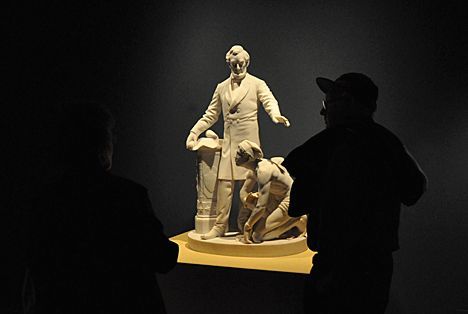
One politician had ideas but they shot him. An impressive memorial to Abraham Lincoln and his hopes for emancipation humble those who stand before it. Some, no doubt, wonder if the war had to happen, although historians say it couldn’t have been prevented because the issues were so divisive.
Jeff Myers, the curator of “The Civil War in Missouri” shares his lunch and his thoughts with us. The preparation of this special exhibit took three years of his life. According to him, his biggest challenge was “what to leave out.”

“My biggest surprise was finding how pervasive guerilla warfare was,” Myers says. “We had, for example, Union soldiers disguising themselves as bushwhackers —
and vice versa. They would go door to door to civilian homes and ask where the sympathies of the occupants lay. The residents didn’t know whom they were dealing with and what response would be the safest. It was psychological warfare —
what has been called ‘the war within the War.’
“I hadn’t realized how horrible it all was,” he continues. “On both sides the retaliations were brutal: Farms burned out, civilians shot and prisoners of war executed.”
Knowing our readers are physicians, he goes on to explain what doctors could do in the field.
did
“Amputations were fast because the surgeon needed to move on to save the next patient,” he says. “In some situations they have chloroform and ether; it was not all biting on a stick as we have been led to believe.”
Civil War history in St. Louis is not confined to this exhibition. The trail for Civil War aficionados leads all over town.
One destination is Jefferson Barracks, the oldest operating U.S. military installation west of the Mississippi. Jefferson has many claims on history. The so-called “Incubator of the U.S. Cavalry,” it provided an escort for merchants on the Santa Fe Trail in 1829 and in 1846 to 1848 organized a mounted regiment to protect travelers on the Oregon Trail, although the troops were finally sent to the Mexican War.
Two hundred and twenty two generals on both sides from the Civil War served here including Jefferson Davis, Robert E. Lee, Philip Sheridan and Grant. Two other U.S. presidents, Zachary Taylor and Dwight D. Eisenhower, served here in uniform. In 1912, Albert Berry made the first successful parachute jump from an airplane on to a targeted area at the barracks.
Gary Stevens, a Civil War buff, hopes for a similar success in a year or two when his group of enthusiasts opens a Civil War museum in the old PX building. Built in 1905, the building was slowly deteriorating (“rotting,” Stevens says) until his volunteer organization started restoration in 2003.
They have in storage muskets and rifles, flags and Confederacy currency, a large medical collection —
and a widow’s trunk with three heartrending letters: the first from her husband, a surgeon, saying he had cut himself during surgery but felt fine. The second letter came from his unit saying he had died of infection. The third was from a major in the regiment advising they had buried him and paid off his debts.
The cost of restoring this 60,000-square-foot building must be a daunting task and any enthusiast of history looking for a way to give a tax-deductible gift would be welcomed.

Nightmare on Elm Street.
The former army hospital building down the road has a collection of medical memorabilia on display, too, although the mannequin representing an army surgeon holding an amputation knife looks more like Freddy Krueger from
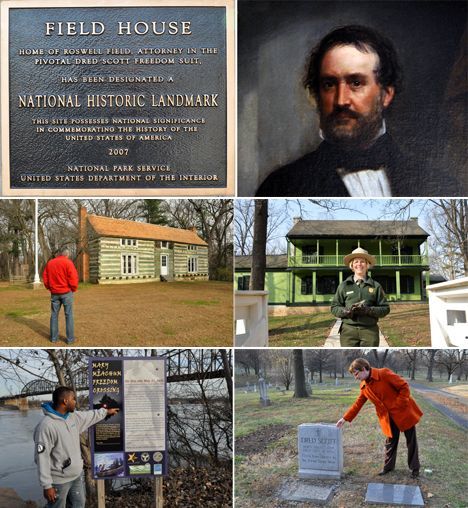
Other historical attractions in town include the home of the lawyer Roswell Martin Field who took the Dred and Harriet Scott case and won it in St. Louis. The Scotts lost their case in the U.S. Supreme Court, which ruled slaves were not citizens and, therefore, could not sue for freedom in federal court. Field’s son, Eugene Field, was the poet whose works include “Little Boy Blue” and “Wynken, Blynken and Nod.”
The “Hardscrabble” log cabin built by Grant and the larger “Whitehaven” home he and his wife, Julia, lived in later would also be of significance for those with historical interest.
he
The first nationally designated Underground Railway site in Missouri, the Mary Meachum Freedom Crossing, lies in town, as do the graves of the Scotts. Buried in Cavalry cemetery, the Dred Scott marker now traditionally has pennies left in memory: Lincoln pennies because freed the slaves!
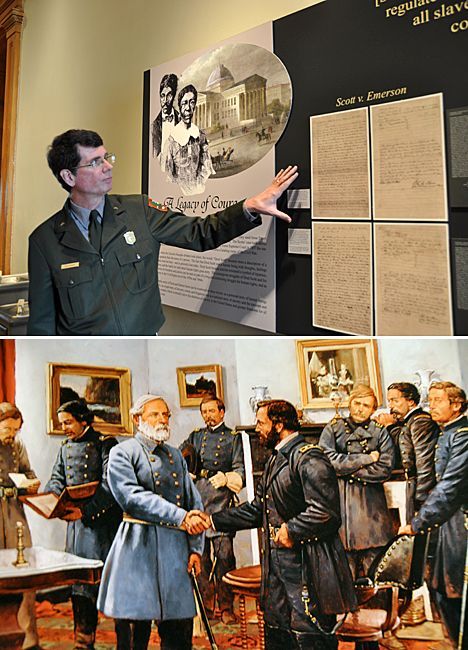
The Dred Scott lawsuit was only one factor advancing this war that killed 600,000 Americans, of course, but we might believe this catalyst that started in the Old Courthouse is the start of our story —
and the end of it is in the Surrender at Appomattox, (the painting by Keith Rocco, photographed courtesy of the National Park Service).

Today serenity rules the night in St. Louis, Mo., not the sound of canons.
Has the country learned anything about war? We would hope one day it would take to heart the insight of the Duke of Wellington who died in 1852, two years after his victory at Waterloo over Napoleon.
“The next dreadful thing to a battle lost is a battle won.”
The Man Who Cried Orange: Stories from a Doctor's Life.
The Andersons, who live in San Diego, are the resident travel & cruise columnists for Physician's Money Digest. Nancy is a former nursing educator, Eric a retired MD. The one-time president of the NH Academy of Family Practice, Eric is the only physician in the Society of American Travel Writers. He has also written five books, the last called




